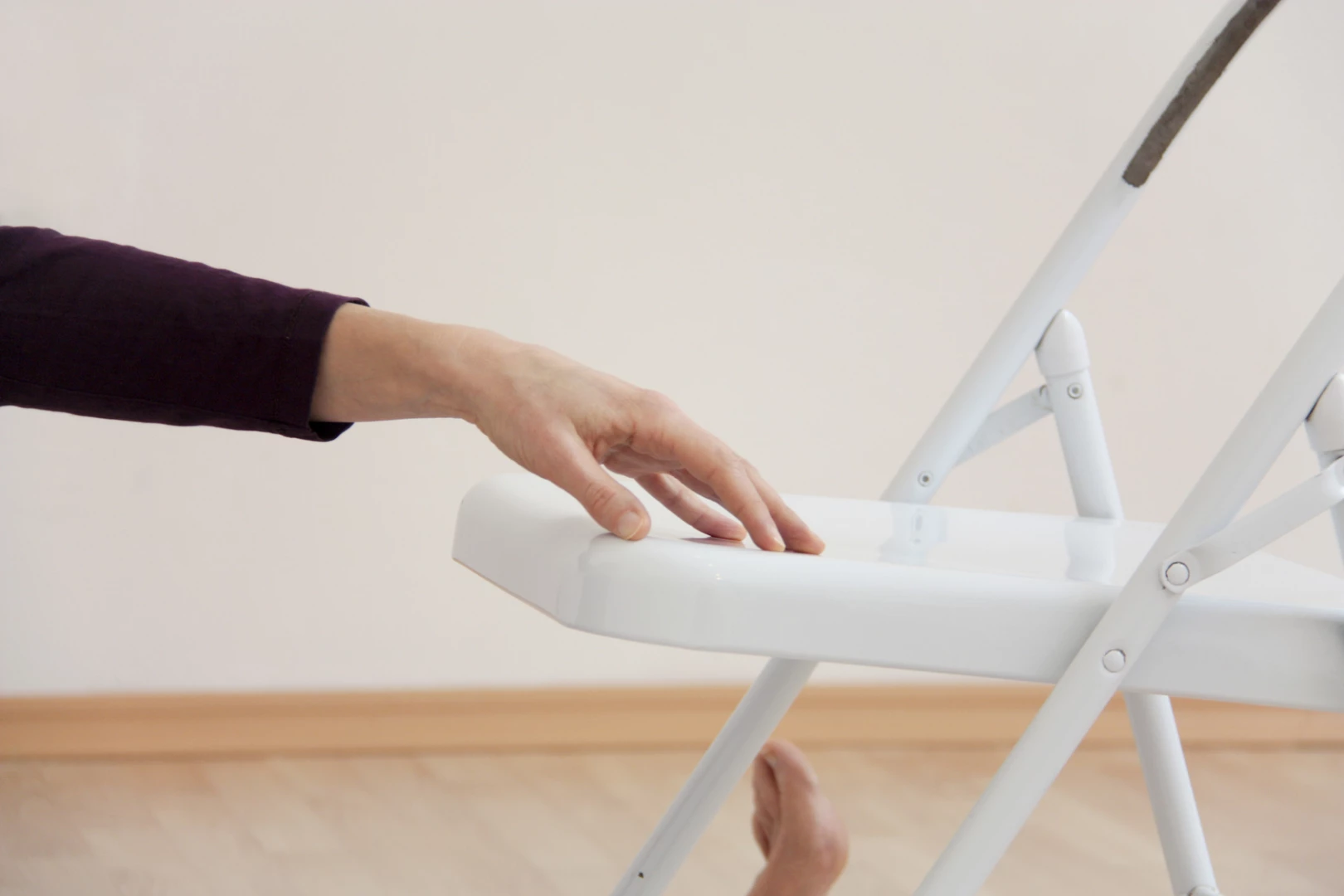Teaching Yoga to Seniors – Ten Tips to Strike the Right Note

More and more seniors are taking up yoga for healthy aging. Yoga teacher Jennifer Williams-Fields offers key tips for teaching yoga to older adults.
Of course, just like my children, I love all my yoga classes equally. But, my big yoga teacher secret is I love teaching seniors’ yoga classes.
I truly love this group of students and want only to see them remain strong and independent. So, after five years of teaching this class, I was devastated when one of my ladies fell hard onto the floor.
I teach senior yoga classes completely off the floor and use a chair for assistance. Not everyone needs the chair for balance, but I always encourage it. I also always encourage them to just try letting go of the chair and balance on their own.
“No one has ever fallen in my class. Yet!” was our running joke in class.
Until the day Miss Louise actually did fall. She cried out, I went running to her and everyone gathered around. Fortunately, aside from her pride, she wasn’t hurt. I, however, was quite rattled.
Ask any aging adult and they will tell you their biggest fear is falling, possibly breaking a bone and becoming dependent upon the care of others. Yoga can decrease the odds of falling by improving balance, posture and self-confidence. The chair provides the students the comfort of assisting them if they need help to balance, alleviating some of the fear of falling.
The chair is not a crutch. It is simply a tool to use, like yoga blocks and straps, to make yoga accessible to everyone.
The other advantage of using a chair in a senior yoga class is it allows everyone a chance to participate. When a new student comes in using a walker or recovering from a stroke, she can stay seated in her chair for the whole class yet complete all the same poses with just a few minor modifications.
Teaching yoga to seniors is incredibly gratifying. But it also requires some extra considerations.
-
Do as I do. Although you most likely teach your regular yoga classes by using more verbal cues than actual demonstration, teaching to a chair-based senior class requires you to actually do the class with them. Remember, this senior population is often hard of hearing so they depend on watching you first. Don’t just say “Warrior I,” actually demonstrate Warrior I. And stay there as long as you expect them to hold the pose. Once you move, the class will follow you and move as well.
-
Right means left and left means right. If doing yoga along with your senior yoga class is important, teaching mirror image is essential. Again, someone in the back row may not be able to hear you, but they will mimic everything you do. Everything. So be very aware of using proper form and technique. If you brush your hair off your face, half your class will put their hand to their face as well. Practice teaching mirror image. Don’t confuse your class by saying raise your right hand yet because you are facing each other it looks like you have the opposite hand up. If you want their right foot raised, you raise your left foot. Teaching mirror image certainly takes some practice to perfect, but it will make your class smoother and easier to follow.
-
Never take your eyes off the class. Ever. The other benefit of teaching mirror image is you can always watch everyone in class to be sure they are staying safe and steady. Constantly scan the room checking knee alignment, posture, or to see if someone’s face is showing signs that she is struggling. My eyes kept going back to Miss Louise right before she fell. In hindsight I realize she was holding on to the chair too tight, putting all her weight into the back of the chair, causing it to tumble over and her to fall.
“I took a fall in church just a couple weeks ago. Because of yoga not only wasn’t I not hurt, but I knew how to get myself up without anyone’s help.” – Robbie age 78
-
Stay off the floor. It’s not reasonable to expect this aging population to flow sun salutations up and down from the floor. My senior yoga classes are always taught with a chair. First we practice the poses sitting in a chair, then, those who can will stand and use the chair for balance.
“We seniors don’t have as many opportunities to get out of the house. Working with the chair and not making us get on the floor makes yoga less intimidating for people and so they are more likely to join the class. The socialization of yoga is just as important as the actual poses.” – Jeanne, age 73
-
Breathe and count. I don’t recommend ever doing pranayama work that includes breath holding in a seniors’ class. Many seniors have COPD or other diminished lung capacity, high blood pressure or heart disease, all of which are contraindicated in breath holding work. You can and should however practice deep three-count breath. Everyone can benefit from filling and expanding the lungs. I also break from traditional yoga teaching and ask my seniors to count out loud as we hold the poses. Counting has two benefits to this population: First, it’s a challenge for them to lift their foot off the ground for five counts. Maybe they get to three today, but they work toward five next week. Second, when the group is counting out loud I know they are breathing.
“The breathing has been the most helpful for me. Even my pulmonologist told me don’t ever quit yoga.” – Jeanne, age 73
-
Use your yoga voice, but a little slower and a little louder. If you are in a gym setting or a studio with a mic system, use it to help everyone hear a little easier. I have a habit of speaking too quickly. I’ve had to learn to slow down the cues to give everyone a chance to understand what I am saying.
-
Keep your shoes on. This is the one yoga class I encourage my students to keep their shoes on. Again, be mindful of the daily struggles of this population. Hip replacements, lower back pain and limited range of motion can make it difficult to complete a basic task like getting shoes on and off. Your senior students will be more comfortable keeping their shoes on.
“I’ve done yoga for five years and I’m now completely off pain meds for my fibromyalgia.” – Meri age 62
-
Use encouraging language. Rather than cuing “raise your arms for tree pose,” I’ll begin by asking my students to lift just one hand off their chair. Then I might add, “If you’re feeling strong and balanced today, let’s try and bring our other hand off the chair as well.” This gives those students who need the extra help permission to hold on to their chair for balance in a way that lets them feel successful.
-
Begin with warming up the larger joints and muscle groups. Finish class focusing on fine motor skills. Simple tasks like buttoning buttons, picking up coins or closing a zipper become difficult with the onset of arthritis. Simple exercises like touching each finger to your thumb or making a tight fist then opening the hands wide can help maintain dexterity. I purchased a cheap bag of old-fashioned clothespins and have my class practice opening and closing the pins using each of their fingers.
“I’ve had back trouble for 60 years, and now neuropathy. Yoga helps keep my range of motion good enough to move my arms all the way over my head. I can reach up to the top shelf or into the dishwasher without any difficulty.” – Jeanette, age 80
-
End with an uplifting message. My group of seniors wouldn’t be comfortable chanting OM. So instead we end with a positive affirmation. A fellow yoga teacher friend ends her classes by asking them to repeat the following saying:
I am free from pain.
I am filled with peace, joy and happiness.
And I am blessed.
Although I was at first nervous to teach this population, I quickly realized that this group is the most grateful, fun and gratifying class I will ever teach. My seniors thank me for giving my time to them. But they don’t realize how much more they have given me.
And I’m happy to report Miss Louise not only got herself up from the floor after she fell, she was back in class the very next week and encouraging her friends to try yoga.

Jennifer Williams-Fields E-RYT, is passionate about writing, yoga, traveling, public speaking and being a fabulous single momma to six super kids. Doing it all at one time, however, is her great struggle. She has been teaching yoga since 2005 and writing since she first picked up a crayon. Although her life is a sort of organized chaos, she loves every minute of the craziness and is grateful for all she’s learned along the way. She is the author of “Creating a Joyful Life: The Lessons I Learned from Yoga and My Mom” now available on Amazon. She co-wrote “Transform Your Life From F’d up To Fabulous” and is featured in other yoga collaboratives. She also is a regular writer for Elephant Journal Magazine, YourTango and YogaUOnline. Follow Jennifer on Twitter @yogalifeway, Instagram @JNELF6 and read her blog.



